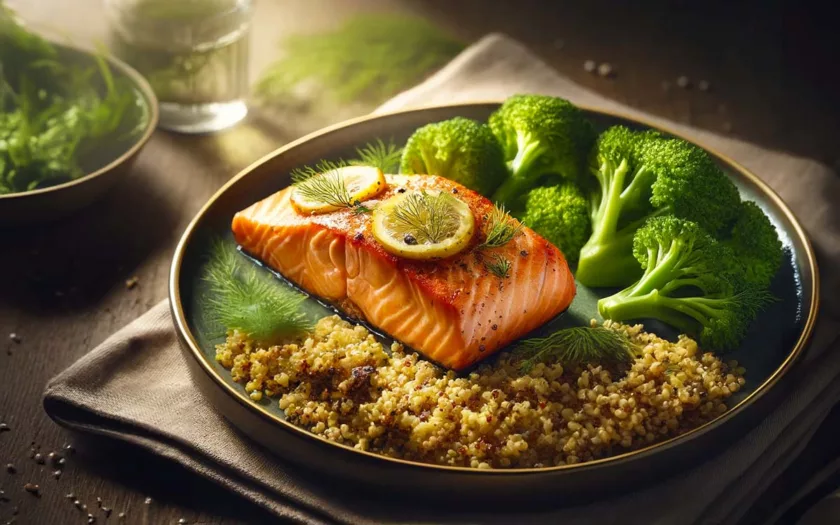Embarking on a weight loss journey involves more than just choosing the right foods; it’s also about how you compose your meals. A well-balanced “weight loss plate” is your canvas for creating nutritious, satisfying meals that fuel your body and support your goals.
The Components of a Weight Loss Plate
Half Vegetables and Fruits: Colorful and packed with nutrients, vegetables and fruits should cover half your plate. They provide essential vitamins and minerals, plus fiber to keep you feeling full.
Quarter Lean Proteins: Protein is pivotal for muscle health and satiety. Fill a quarter of your plate with sources like poultry, fish, legumes, or tofu.
Quarter Whole Grains and Healthy Fats: The final quarter should include whole grains for sustained energy, complemented by a modest amount of healthy fats, such as those from avocados or nuts, for additional satiety and flavor.
Portion Control Tips
Using smaller plates can naturally help manage portions, and tuning into your hunger cues promotes mindful eating. Remember, it’s not just about the quantity of what’s on your plate but the quality.
The Role of Hydration
Hydration is key to weight loss and overall health. Aim to have a glass of water with each meal to aid digestion and help control hunger.
Sample Meal Ideas
- Breakfast: A vibrant omelet filled with spinach and mushrooms, served with a side of whole-grain toast and avocado.
- Lunch: Grilled chicken salad with a rainbow of vegetables, dressed with olive oil and lemon juice.
- Dinner: Baked salmon with quinoa and steamed broccoli, offering a perfect blend of protein, grains, and veggies.
Conclusion
The “weight loss plate” is more than a diet strategy; it’s a sustainable approach to eating. By focusing on balance and variety, you can enjoy delicious meals that support your weight loss without feeling deprived.
We’d love to see how you bring the concept of the weight loss plate to life. Share your creations and experiences, and let’s inspire each other toward healthier, happier lives.

Baked Salmon Delight: A Nutritious Trio of Salmon, Quinoa, and Broccoli
Equipment
- 1 baking sheet Preferably non-stick or line with parchment paper for easier cleanup.
- 1 Medium Saucepan For cooking quinoa. Choose one with a tight-fitting lid to ensure proper steam cooking
- 1 Steamer Basket For steaming the broccoli. If you don’t have a steamer basket, a colander placed over a pot of boiling water, covered, can work as an alternative.
- 1 Measuring Cups and Spoons For accurately measuring ingredients such as quinoa, water/broth, olive oil, and seasoning.
- 1 Mixing bowl For mixing olive oil, lemon juice, and seasoning for the salmon.
- 1 Fork To fluff the quinoa after cooking and to check the doneness of the salmon
- 1 Knife For chopping broccoli into florets and any prep work for optional herbs.
- 1 Cutting board For preparing broccoli and any additional ingredients that require chopping.
Ingredients
For the Salmon
- 4 6 oz. Salmon Fillets Look for fresh or frozen fillets with vibrant color; skin-on or skinless based on preference.
- 2 tbsp Olive Oil Extra virgin olive oil is preferred for its flavor and health benefits.
- 1 tbsp Lemon Juice Freshly squeezed lemon juice offers the best flavor.
- To Taste Salt
- To Taste Pepper
- As Desired Herbs and Spices Dill, garlic powder, and paprika are great options for enhancing flavor.
For the Quinoa
- 1 cup Quinoa Rinse under cold water before cooking to remove bitterness.
- 2 cups Water or Vegetable Broth Vegetable broth adds more flavor to the quinoa.
- Pinch Salt
For the Broccoli
- 1 large Broccoli head Cut into florets; rinse well.
- To Taste Salt
- To Taste Pepper
Instructions
- Preheat your oven to 375°F (190°C) to prepare for baking the salmon.
- In a small mixing bowl, whisk together olive oil and lemon juice. Brush the mixture over the salmon fillets, then season with salt, pepper, and optional herbs and spices. Place the fillets on a baking sheet lined with parchment paper.
- Bake the salmon in the preheated oven for 12-15 minutes, or until the salmon flakes easily with a fork. The exact time may vary depending on the thickness of the fillets.
- While the salmon is baking, rinse the quinoa under cold water. In a medium saucepan, bring the water or vegetable broth to a boil. Add the rinsed quinoa and a pinch of salt, reduce the heat to low, cover, and simmer for about 15 minutes, or until the water is absorbed. Remove from heat and let it sit covered for 5 minutes, then fluff with a fork.
- Steam the broccoli florets until tender but still bright green, about 4-5 minutes. This can be done in a steamer basket over boiling water or in a microwave-safe dish with a bit of water.
- Divide the cooked quinoa among plates, top with a baked salmon fillet, and serve with a side of steamed broccoli. Optionally, drizzle extra lemon juice over the salmon and broccoli for added flavor.

